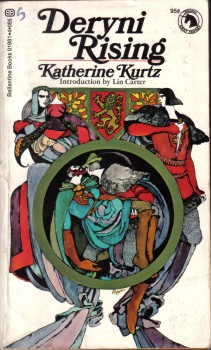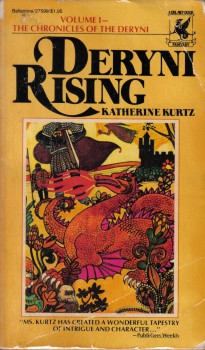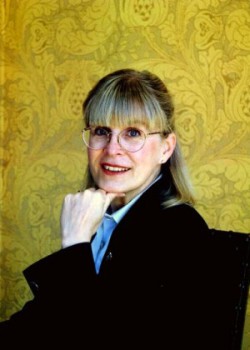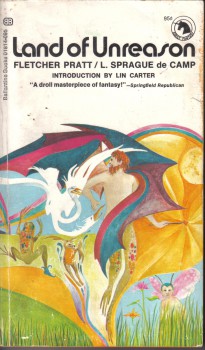The Ballantine Adult Fantasy Series: Deryni Rising by Katherine Kurtz
 Deryni Rising
Deryni Rising
Katherine Kurtz
August 1970
271 p., $0.95
Cover art by Bob Pepper
When Lin Carter started the Ballantine Adult Fantasy line, he began by reprinting works that were obscure and/or considered classic in the field at that time, but as he wrote in the introduction to Deryni Rising, he had hoped from the very beginning to be able to publish high quality new works as well. The first original fiction he published was Deryni Rising, the first novel by Katherine Kurtz.
I think he hit the ball out of the park when he selected this one.
The story takes place in a pseudo-Welsh land called Gwynedd,. The book opens with the murder of King Brion Haldane by the sorceress Charissa. Brion and his closest friend Alaric Morgan defeated and killed her father some years ago. Brion’s murder is part of her plan for revenge.
Brion has, or rather had, the ability to practice Deryni magic. The Deryni are a long-lived race with inherent magical abilities. A few generations ago, humans and Deryni lived together in peace until a group of Deryni rose to power and severely oppressed the humans in Gwynedd. They were overthrown by a Deryni priest named Camber, who discovered a way to impart the Deryni’s magical powers to ordinary humans. At first, Camber was considered a saint, but later the Church declared him a heretic. Now some humans tolerate the Deryni, while others seek to exterminate them. Most Deryni keep a low profile. Morgan is part Deryni and doesn’t hide that fact.
Brion’s son Kelson is next in line to ascend the throne, even though he’s a few weeks short of his majority at the time of his father’s death. Kelson’s mother, Queen Jehanna, hates Morgan and all Deryni. She does everything in her power to turn Kelson against Morgan, who is now a general. Morgan, on the other hand, is doing everything he can to find a way to complete the ritual that will transfer Brion’s magical abilities to Kelson. He’s aided in this endeavor by Morgan’s cousin Duncan. The latter man is an archbishop and secretly a Deryni. He’s also Kelson’s father confessor.

With the exception of the first chapter, in which Brion is murdered, most of the book takes places over the few days leading up to Kelson’s coronation, which happens after he turns 14, the age of legal majority in Gwynedd.
There is some swordplay as well as a sorcerous battle, but much of the conflict comes from the political maneuverings of Jehanna, Kelson, Morgan, Charissa’s allies, and Duncan. It’s in these scenes that I felt Kurtz excelled.
Kurtz employs a changing viewpoint, so that the reader knows what all the central characters are thinking. And by that I mean the viewpoint changes frequently and without warning, allowing us to see how different people react to the same events and conversations.
I found Deryni Rising to be compulsively readable. It was by far the easiest to read of all the BAF titles I’ve covered up to this point. A main reason for that is that the prose in this book is the most modern and accessible to today’s readers.
When I was a teenager, the Deryni books were everywhere. Kurtz was actively expanding her world. Today there are 15 novels with another scheduled for release later this year.
I’d never read any of the Deryni novels until now, in spite of their near ubiquity when I was younger. Part of that was because I really didn’t get interested in fantasy until the last couple of years of high school, and even then I tended to choose science fiction over fantasy. Now it’s the reverse. I read fantasy more than science fiction. (The reasons for this are beyond the scope of this post.)
I can see why they were so popular then and why they have remained popular to this day. I think there are two main reasons for their popularity.
The first reason is that Kurtz is an extremely capable writer, one who deserves every bit of her success. I cared about the characters, especially Morgan, against whom Charissa engages in some extremely underhanded attacks. Kurtz created quite a sense of dread in places. Since this was her first novel, I can only expect the overall quality of the series to increase with later volumes.

The second reason has to do with the timing of their writing. Deryni Rising was published in 1970. At that time, there wasn’t a great deal of fantasy on the shelves. Carter and de Camp had brought back Conan, and a few other Howard characters were beginning to show up in print after an absence of many years. Tolkien, of course, had become immensely popular, and before launching the BAF line, Ballantine had reprinted some novels by E. R. Eddison, most notably The Worm Ouroboros, in an attempt to capitalize on LotR’s popularity.
But other than those titles and a few more scattered here and there, the whole pseudo-medieval fantasy boom had yet to take off. The success of LotR proved that there was an audience for this type of fantasy. Kurtz’s Deryni Rising was just what readers wanted.
The Deryni novels are about as medieval European as you can get. They’re set in a time period that closely resembles the 10th and 11th centuries. There are castles, sorcerers, a race that resembles Tolkien’s elves in some ways (and only in some ways), a powerful church that frowns on magic.
By the end of the decade, fantasy would be booming, and Ballantine, under its Del Rey imprint, would be one of the premier publishers. Carter and Lester del Rey, who took over the Ballantine science fiction and fantasy line, would publish a number of fantasy authors, such as Terry Brooks, Phyllis Eisenstein, Brian Daley, and H. Warner Munn, plus a host of others who have faded from public consciousness. And of course, Ballantine continued to publish Kurtz long after the BAF line had published its last novel.
 I said when I started this series that I would attempt to read at least one book by each author represented, but made no promises beyond that. If I liked a writer’s work, I would read more volumes. If not, that was it. The first three Deryni novels constitute a trilogy, and all were published under the BAF imprint. I’ll be reading the other two.
I said when I started this series that I would attempt to read at least one book by each author represented, but made no promises beyond that. If I liked a writer’s work, I would read more volumes. If not, that was it. The first three Deryni novels constitute a trilogy, and all were published under the BAF imprint. I’ll be reading the other two.
Next time, I pick up where we left off chronologically, with Land of Unreason by L. Sprague de Camp and Fletcher Pratt. Join me, won’t you?
Previous posts in this series are:
Lin Carter and the Ballantine Adult Fantasy Series
The Blue Star by Fletcher Pratt
The King of Elfland’s Daughter by Lord Dunsany
The Wood Beyond the World by William Morris
Lilith by George MacDonald
The Silver Stallion by James Branch Cabell
The Sorcerer’s Ship by Hannes Bok
Keith West blogs way more than any sane person should. His main blog is Adventures Fantastic, which focuses on fantasy and historic fiction.
I have a lot of the BAF, though I never managed to acquire all of them. It seems to me that it’s time for the series to be republished. I’d like to see the original covers and Carter material retained, but with additional introductions from current writers who first encountered the books through the old Ballantine editions. C’mon, someone – this is a winner!
Ditto to what Thomas Parker said.
But, in the meantime, I’m still collecting these old volumes.
I very much enjoyed the first three trilogies in this series and recommend them without reservations (though I favor the first six of the nine books).
I struggled a bit with The Heirs trilogy and actually haven’t read any of the Childe Morgan set.
But Kurtz really created a strong series with the Deryni.
I have a couple of the Deryni books, but haven’t read them. Have you seen Ursula Le Guin’s essay “From Elfland to Poughkeepsie”? Le Guin quotes from one of the Deryni books, making changes in the names to show the passage’s complete absence of fantasy’s “distancing from the ordinary.” The effect, for me, was just to kill any interest in giving the books a try.
I’ve read that essay also, but while I see the point le Guin is making, I disagree that it’s a _bad_ thing that this book doesn’t have as much “distancing from the ordinary” — it just means it’s a different _type_ of fantasy, but isn’t any less valid.
I’ve only read the Camber books and this trilogy; I did enjoy them. To quote from my Goodreads review, Kurtz seemed to be one of the first authors to try to split the middle between Tolkienian epic fantasy and Howardian sword & sorcery; I think you can draw a pretty clear through-line from the Deryni books all the way up to Game of Thrones.
Thomas, I agree, it would be great to have these books reprinted with original cover art and mew introductions.
Thomas and James, I don’t see copies as often as I used to. How close to having a full set are you?
Major, I’m not familiar with that essay. Where can I find it?
Joe, I thought this first volume was much more in the spirit of Tolkien. I didn’t see much Howardian influence. Maybe in the later books?
Well, I meant in the sense that things were happening on a much more human scale — no Dark Lord or Ringwraiths or anything; just armies and politics. And neither the pure-strain humans nor the Deryni seem inherently good or evil; both take turns being oppressed and oppressor.
The le Guin essay shouldn’t be too hard to track down; I think it’s been reprinted multiple times, including in her collection Languages of the Night.
One of these days I need to reread the Camber trilogy. And maybe check out some of the others.
I’ve probably got 40 or so, out of the 65 “official” books in the series. A lot of my copies are the ones I bought when they originally came out – I just read my copy of Hyne’s the Lost Continent for the first time a few weeks ago, almost forty years after buying it. Vintage paperbacks are like vintage wine that way; you have to wait until they – or you – have aged properly.
I have most of the books in the series, missing, at most, 2-3. My favorite has to be Mervyn Peake’s “Titus Groan,” first book of the Gormenghast trilogy. I’d love to see the entire series brought back into print, and perhaps some new titles added to the list.
I’ll echo Mr. Parker’s comments, having also bought the books as they were printed, and when I read Peake’s Gormenghast books, I’d owned them for close to 40 years as well. Does an “official” list exist somewhere? I’d be curious to see what I’m missing.
Smitty, there’s a BAF article on (of course) Wikipedia.
Joe, I see what you mean about no Dark Lords but more personal conflict. I’ll try to track down the le Guin essay. Thanks for the info on where it’s located.
Thomas and smitty59, I was still in diapers when the first volumes were published. I envy you the thrill of new titles coming out every month. Thomas your comment about aging properly is spot on. There are some books I would enjoy now that I wouldn’t when younger (and vice versa.) I haven’t read Hyne or Peake yet.
This is the list I’m using, since it has pre-BAF titles, associated titles, and cover art all in one place:
http://www.nightfallbooks.com/bafs.html
I love seeing all of those covers in one glorious assemblage.
Thomas — Thanks for the Wikipedia heads-up! Don’t know why I didn’t think of that —
Thomas I just checked out the Wikipedia entry — and got a little better “educated.” The Gormenghast books were not part of the original 65-title set, but published earlier; my copies were all reprinted a few years later with the unicorn logo added. I also have almost all of the 65 titles; the only two I never purchased were titles I already had in different publishers’ editions. And in response to westkeith: I was lucky enough to have a factory job that paid me well enough to buy all the SF/Fantasy I could have wanted — at the same time that the job made the escape into my imagination that much more crucial to my mental stability.
[…] Read Keith’s complete comments here. […]